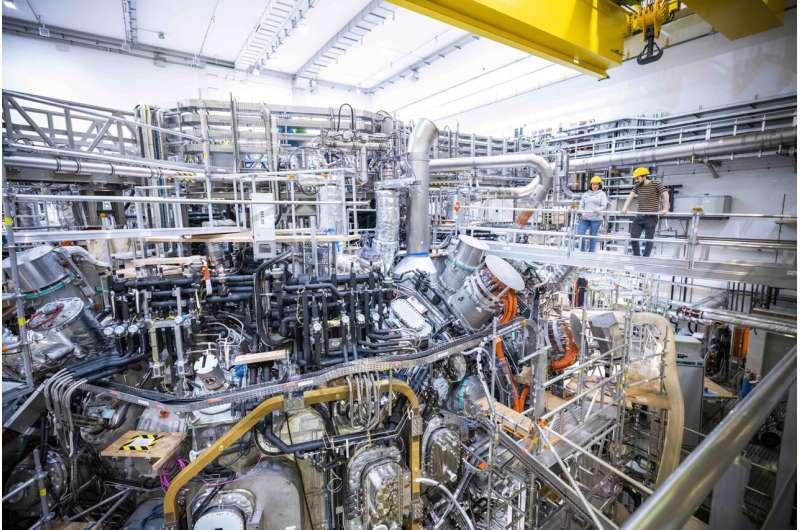SCI FI TECH
Power plasma with gigajoule energy turnover generated for eight minutes

After successful recommissioning in autumn 2022, the Greifswald nuclear fusion experiment has surpassed an important target. In 2023, an energy turnover of 1 gigajoule was targeted. Now the researchers have even achieved 1.3 gigajoules and a new record for discharge time on Wendelstein 7-X: the hot plasma could be maintained for eight minutes.
During the three-year completion work that ended last summer, Wendelstein 7-X was primarily equipped with water cooling for the wall elements and an upgraded heating system. The latter can now couple twice as much power into the plasma as before. Since then, the nuclear fusion experiment can be operated in new parameter ranges.
"We are now exploring our way towards ever higher energy values," explained Prof. Dr. Thomas Klinger, head of the Stellarator Transport and Dynamics Division at the Max Planck Institute for Plasma Physics (IPP) in Greifswald. "In doing so, we have to proceed step by step so as not to overload and damage the facility."
On 15 February 2023, the researchers reached a new milestone: for the first time, they were able to achieve an energy turnover of 1.3 gigajoules in this device. This was 17 times higher than the best value achieved before the conversion (75 megajoules). The energy turnover results from the coupled heating power multiplied by the duration of the discharge. Only if it is possible to couple large amounts of energy continuously into the plasma and also remove the resulting heat, a power plant operation is possible.
The plasma discharge lasted eight minutes
Particularly heat-resistant divertor baffle plates are used to dissipate the largest heat flows at Wendelstein 7-X. They are part of the inner wall, which is now cooled by a system of 6.8 kilometers of water pipes since the completion of the device. No other fusion facility in the world currently has such a comprehensively cooled inner wall.
The plasma heating consists of three components: the newly installed ion heating, the heating by neutral particle injection and electron microwave heating. For the current record, the electron microwave heating system was particularly important because it delivers large amounts of power over periods of several minutes.
The energy turnover of 1.3 gigajoule was achieved with an average heating power of 2.7 megawatts, whereby the discharge lasted 480 seconds. This is also a new record for Wendelstein 7-X and one of the best values worldwide. Before the completion works, Wendelstein 7-X achieved maximum plasma times of 100 seconds at much lower heating power.
Within a few years, the plan is to increase the energy turnover at Wendelstein 7-X to 18 gigajoules, with the plasma then being kept stable for half an hour.
Background to nuclear fusion
The goal of fusion research is to develop a climate and environmentally friendly power plant. Similar to the sun, it is to generate energy from the fusion of atomic nuclei. The Max Planck Institute for Plasma Physics is pursuing the path of magnetic fusion. Because the fusion fire only ignites at temperatures above 100 million degrees, the fuel—a thin hydrogen plasma—must not come into contact with cold vessel walls.
Held by magnetic fields, it floats almost contact-free inside a vacuum chamber. The magnetic cage of Wendelstein 7-X is created by a ring of 50 superconducting magnetic coils. It is a stellarator-type facility in which the special shapes of the coils are the result of sophisticated optimization calculations. With the help of these coils, the quality of plasma confinement in a stellarator should reach the level of competing tokamak-type facilities.
Provided by Max Planck Society
No comments:
Post a Comment